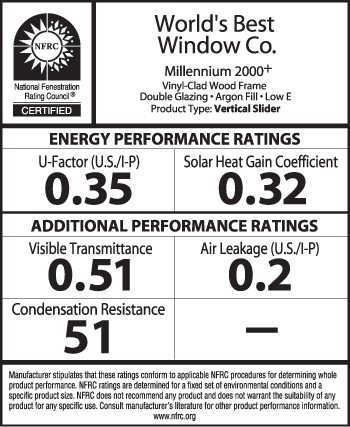U-Factor Ratings for Windows

 Council (NFRC). The NFRC is a non-profit group that administers a uniform, independent rating and labeling system for the energy efficiency of building components, including windows, doors, skylights and attachment products. The U.S. Department of Energy and the Environmental Protection Agency’s Energy Star Program take the U-factor into account when evaluating the energy efficiency of windows for product certifications, and federal incentive and rebate programs.
Council (NFRC). The NFRC is a non-profit group that administers a uniform, independent rating and labeling system for the energy efficiency of building components, including windows, doors, skylights and attachment products. The U.S. Department of Energy and the Environmental Protection Agency’s Energy Star Program take the U-factor into account when evaluating the energy efficiency of windows for product certifications, and federal incentive and rebate programs.The temperature difference between the interior and exterior of a building creates the non-solar heat flow that results in windows losing heat to the outside during the winter, and gaining heat from outside during the summer. Compensating for this by cranking the thermostat or turning up the AC results in added energy needs and higher bills. Greater energy efficiency calls for a closer examination of the individual building components to see how they can work individually and in relation to each other in more effective ways. U-factor ratings can help in formulating standardized comparisons and objective evaluations.
Determining the U-Factor
The U-factor generally refers to the energy efficiency of the complete window assembly, which includes the glazing, window frame and spacer. The spacer is the component of a window frame that separates the glazing panels, and often reduces the U-factor at the glazing edges. The performance rating of the glazing alone, independent of the frame, is known as the center-of-glass U-factor, but use of this rating is less common. For most energy-efficient windows, the U-factor for the entire window assembly is higher than the U-factor at the center of the glass.
U-Factors in Different Climates
While beneficial in cooling-dominated climates, a low U-factor is most important for windows in heating-dominated climates. The following are recommendations for the most effective window U-factors based on the major climate zones in the United States.
- In colder climates in the North that are heating-dominated, the U-factor should be less than or equal to 0.30 for windows, and less than or equal to 0.55 for skylights. In areas where air-conditioning needs are minimal, windows that allow for solar heat gain during the day (a solar heat-gain coefficient of 0.40 or higher) can be considered energy-efficient with a U-factor as high as 0.32. Low U-factor windows are most important and will be most effective in this colder climate area where minimizing heat loss is critical to energy efficiency.

- In mixed climates in the North and Midwest regions that use both heating and cooling, the U-factor should be less than or equal to 0.32 for windows, and less than or equal to 0.55 for skylights. Heating bills can help determine the importance of U-factors in this climate. Higher bills indicate the importance windows with a lower U-factor for added energy efficiency.
- In mixed climates in the South and central regions that use both heating and cooling, the U-factor should be less than or equal to 0.35 for windows, and less than or equal to 0.57 for skylights. In these climates, again, heating costs can determine if a lower U-factor could be beneficial and more energy-efficient. If costs are high and a list of factors for heat loss is being addressed, window U-factor can be taken into consideration. A low U-factor for windows can also be helpful during hotter seasons when it is important to keep heat out, though a low solar heat-gain coefficient is more important in such situations.
- In hot climates in the South that are cooling-dominated, the U-factor can be less than or equal to 0.60 for windows, and less than or equal to 0.70 for skylights. A lower U-factor is still useful during any cold times of the year when heating is needed in this climate. Such low ratings can ensure that heat is kept out on hot days when combined with a low solar heat-gain coefficient, which is the most important consideration in this climate.

